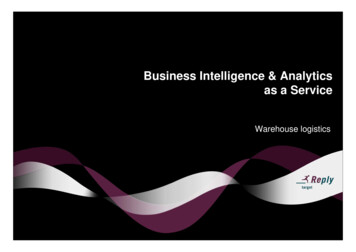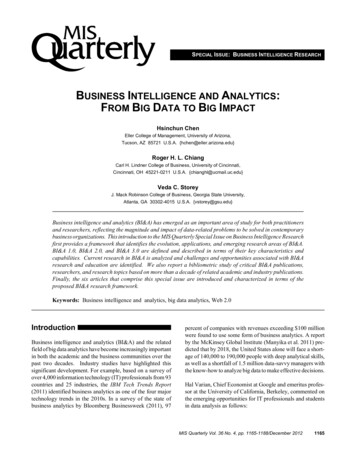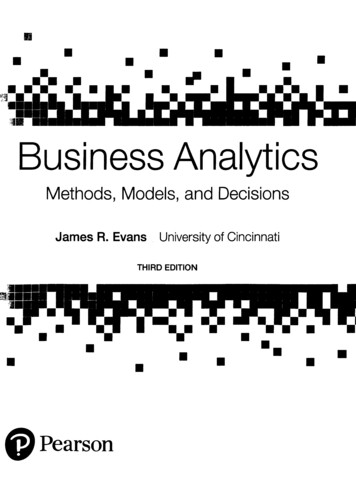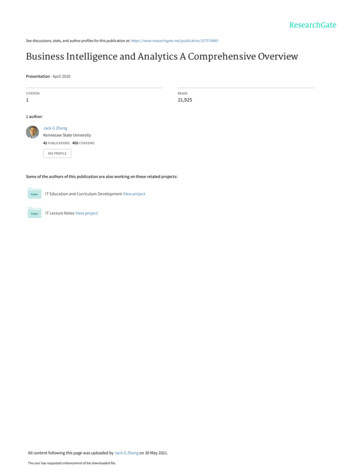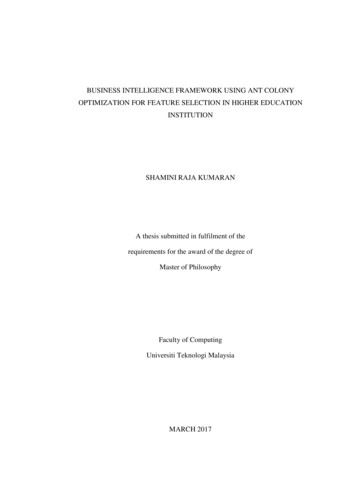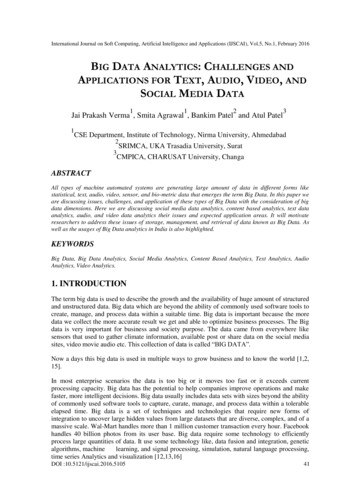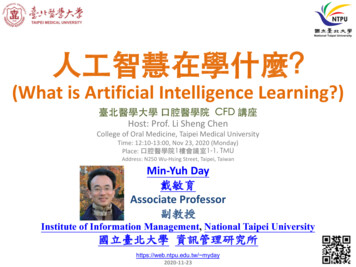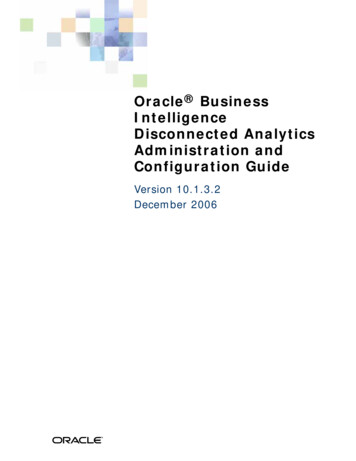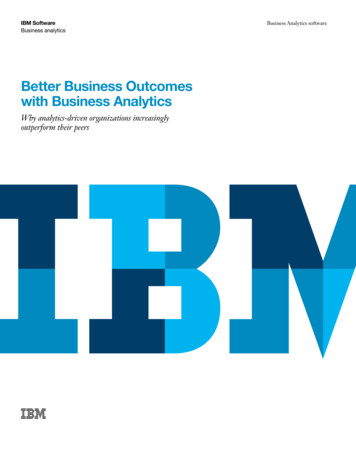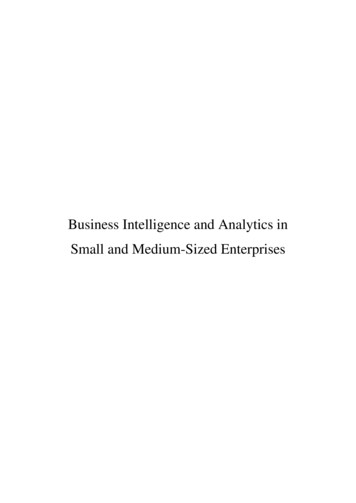
Transcription
Business Intelligence and Analytics inSmall and Medium-Sized Enterprises
Marilex Rea LlaveBusiness Intelligence and Analytics inSmall and Medium-Sized EnterprisesDissertation for the degree philosophiae doctorUniversity of AgderFaculty of Social Sciences2020
Doctoral Dissertations at the University of Agder 282ISSN: 1504-9272ISBN: 978-82-7117-984-7 Marilex Rea Llave, 2020Printed by 07 MediaKristiansand
This thesis has been submitted to theDepartment of Information Systems,Faculty of Social Sciences,University of Agder, Kristiansand, NorwayDefense date: August 28th, 2020Evaluation CommitteeJos van Hillegersberg, ProfessorUniversity of Twente, NetherlandsAnne Mette Fuglseth, ProfessorNHH Norwegian School of Economics, NorwayBjørn Erik Munkvold, ProfessorUniversity of Agder, NorwaySupervisorsDag H. Olsen, ProfessorUniversity of Agder, NorwayEli Hustad, ProfessorUniversity of Agder, Norway
This thesis is dedicated tomy beloved late father, Alexander Sacramento Llaveand my beloved mother, Celia Rea Llave.
AcknowledgementsThe long and winding road towards a PhD has been a remarkable experience. Itwas a journey of unceasing yet interesting challenges. For this, I would like tothank the University of Agder and the Department of Information Systems.I want to express my sincerest gratitude to my supervisors, Professor Dag H. Olsenand Professor Eli Hustad. Dag, you are a great thinker and listener. You patientlyread my work and answered my endless questions. Eli, you assisted me with yourexceptional skills and reminded me that I could get through this. You motivatedme and were a ray of sunshine. I am forever grateful for both of your patience,encouragement, and guidance throughout this journey. Your unwaveringenthusiasm for research has kept me engaged with my PhD study. I am trulyfortunate to have you as my “research parents”.I extend my appreciation to the amazing people at the Department of InformationSystems. To Professor Maung Kyaw Sien and Professor Devinder Thapa, thankyou for the career advice and for having “Filipino lunches” with me. Thank youfor the entertaining talks on life, Hans Olav Egeland Omland and Hallgeir Nilsen.And to the rest of my colleagues, Amna, Anna-Lene, Ilias, Janis, Charlotte, Tonje,Even, Jaziar, Terje, Margunn, Xenia, Tim, Niels, Sara, Tom, Ivan, Cathrine,Kristine, Lucia, Sindi, Tumaini, and Tove, you are all wonderful people. To myfellow PhD students who stood by me and supported me throughout my endeavor,Anne Kristin, Tafiqur, Geir Inge, Aleksandra, Kirsti, Peter, Nam, Tika, Frank, JanHelge, Narayan, and Ole Kristian. It would have been a lonely journey withoutyou guys.Special thanks to Professor Bjørn Erik Munkvold, who informed me about thisPhD job opportunity. Thank you to our former department head, Professor LeifSkiftenes Flak, who welcomed me on my first day of work. Thank you to ourdepartment head, Professor Carl Erik Moe, who entrusted me with teachingresponsibilities during my PhD. To Professor Øystein Sæbø, thank you for thedifferent teaching styles and techniques you have taught me and for helping mesurvive my first teaching experience.ix
To my beloved mother, Celia Rea Llave, thank you for the unconditional love,patience, and support that have made me the person I am today. Thank you forputting in the effort to give me the best life you could provide. I am very lucky tohave a kindhearted yet strong mother. I also want to acknowledge my beloved latefather, Alexander Sacramento Llave, who worked hard and did his best to give usthe life we deserved. I miss you so much, Papa! You and mom are my biggestinspiration. I hope I have made both of you proud. I love you both to the moon andback.I also want to thank my two sisters for their love and support. To my younger sister,thank you for taking care of mom and for being a great mother to my nephew. Youare one of the most caring person I know. To my big sister, thank you for all yourhard work and sacrifice to help mom put food on our table after our father died.You are one of the most generous person I know. I am lucky to have both of youas my sisters and in my life. To my wonderful nephew and niece, thank you forbringing so much joy and happiness into my world. I promise to always be therefor the both of you and be the “cool aunt”. To the kindest brother-in-law anyonecould ever have, thank you for loving my big sister, my niece, and the entire family.You are a wonderful person with a big heart.Last but not least, I owe thanks to a very special person, for his continued andunfailing love, support, and understanding. You were always around at times Ithought that it’s almost impossible to continue. I am truly grateful for everythingyou have done for me. You mean so much to me!x
List of NBusiness AnalyticsBusiness IntelligenceBusiness Intelligence and AnalyticsCustomer Relationship ManagementCritical Success FactorDatabase Management SystemDeLone and McLeanDiffusion of Innovation TheoryDecision Support SystemData WarehouseExecutive Information SystemEnterprise Resource PlanningExtract-Transform-LoadInternet of ThingsInformation SystemsInformation TechnologyKnowledge ManagementKey Performance IndicatorManagement Information SystemPersonal Decision Support SystemResource-Based ViewSoftware-as-a-ServiceSupply Chain AnalyticsSupply Chain ManagementSmall and Medium-Sized EnterpriseTechnology Acceptance ModelTechnology, Organization, and EnvironmentUnified Theory of Acceptance and Use of TechnologyValuable, Rareness, Inimitable, and Non-substitutablexi
xii
AbstractThis thesis presents a study of Business Intelligence and Analytics (BI&A)adoption in small and medium-sized enterprises (SMEs). Although the importanceof BI&A is widely accepted, empirical research shows SMEs still lag in BI&Aproliferation. Thus, it is crucial to understand the phenomenon of BI&A adoptionin SMEs.This thesis will investigate and explore BI&A adoption in SMEs, addressing themain research question: How can we understand the phenomenon of BI&Aadoption in SMEs? The adoption term in this thesis refers to all the IS adoptionstages, including investment, implementation, utilization, and value creation. Thisresearch uses a combination of a literature review, a qualitive exploratoryapproach, and a ranking-type Delphi study with a grounded Delphi approach. Theempirical part includes interviews with 38 experts and Delphi surveys with 39experts from various Norwegian industries.The research strategy investigates the factors influencing BI&A adoption in SMEs.The study examined the investment, implementation, utilization, and valuecreation of BI&A technologies in SMEs. A thematic analysis was adopted tocollate the qualitative expert interview data and search for potential themes. TheDelphi survey findings were further examined using the grounded Delphi method.To better understand the study’s findings, three theoretical perspectives wereapplied: resource-based view theory, dynamic capabilities, and IS value processmodels.The thesis’ research findings are presented in five articles published ininternational conference proceedings and journals. This thesis summary willcoherently integrate and discuss these results.The thesis makes five contributions. First, it provides an overview of BI&Aadoption in SMEs by synthesizing extant research contributions on this topic.Second, the study contributes to the research stream on BI&A adoption in SMEsby identifying the core drivers and inhibitors, focusing on the lack of resources toexplain the slow adoption or non-adoption of BI&A. Third, the study demonstrateshow BI&A helps generate business value. Fourth, the thesis suggests an iterativexiii
and gradual approach as preferable for SMEs and proposes a revised IS valueprocess model to represent the iterative and dynamic nature of BI&A. Finally, thestudy illustrates the combination of the three theoretical perspectives, whichcontributes to a better understanding of the findings. In addition, this thesispresents a set of recommendations to help SMEs achieve successful BI&Aadoption and value creation. Furthermore, the combination of a ranking-typeDelphi study with a grounded Delphi approach and exploratory qualitative expertinterviews offers a rigorous methodological approach to gain a deeperunderstanding of BI&A adoption in SMEs.xiv
Table of Contents1 Introduction . 12 Theoretical Background . 52.1 The Resource-Based View . 52.2 The Dynamic Capabilities View . 82.3 IS Value Models . 123 Related Literature . 193.1 Business Intelligence and Analytics . 193.1.1 Business Intelligence, Business Analytics, and Big Data . 203.1.2 BI&A Architecture . 223.1.3 BI&A Evolution and Trends . 233.1.4 BI&A Business Value Creation . 263.2 Small and medium-Sized Enterprises and Information Systems . 283.2.1 The SME Context and Environment . 283.2.2 The SMEs’ Unique Characteristics . 303.3 IS Adoption . 323.4 IS Adoption in SMEs . 363.5 BI&A Adoption . 393.6 BI&A Adoption in SMEs . 434 Research Approach . 474.1 Research Design . 474.2 Getting Informants on Board . 494.3 Data Collection . 534.3.1 Qualitative Interviews . 534.3.2 Delphi Study . 544.4 Data Analysis. 584.5 Validity Issues . 625 Research Publications . 655.1 Paper 1: A Review of Business Intelligence and Analytics in Small andMedium-Sized Enterprises . 655.1.1 Presentation . 665.1.2 Findings . 665.2 Paper 2: Creating Value from Business Intelligence and Analytics inSMEs: Insights from Experts . 675.2.1 Presentation . 67xv
5.2.2 Findings . 685.3 Paper 3: Drivers for Business Value Creation of Business Intelligence:The Expert’s View . 695.3.1 Presentation . 695.3.2 Findings . 695.4 Paper 4: Data Lakes in Business Intelligence: Reporting from theTrenches . 705.4.1 Presentation . 715.4.2 Findings . 715.5 Paper 5: Creating Strategic Business Value from BI&A: Navigating theDire Straits between Investment and Performance . 725.5.1 Presentation . 725.5.2 Findings . 726 Contributions . 756.1 Contribution to Research . 756.2 Contribution to Practice. 826.3 Methodological Contribution . 867 Conclusions . 877.1 Summary. 877.2 Limitations and Suggestions for Future Research. 88References . 91Appendices . 115Appendix A: Documentation of Data Collection . 115Appendix B: Research Publications . 157xvi
List of FiguresFigure 2.1: How IT creates business value: A process theory . 14Figure 2.2: IT business value model . 14Figure 2.3: Synthesized IS business value model. 15Figure 2.4: A framework of how BI&A creates business value . 17Figure 3.1: Evolution of decision support technologies . 20Figure 3.2: BI&A architecture . 23Figure 3.3: The diffusion of innovations framework . 33Figure 3.4: The technology, organization, and environment framework . 34Figure 4.1: Overview of research activities . 49Figure 4.2: Summary of the Delphi phases and follow-up interviews . 55Figure 4.3: Example of analyzing the list of drivers based on the validation round . 60Figure 6.1: Core drivers and inhibitors for BI&A adoption in SMEs mapped onto the ISvalue process model . 76Figure 6.2: The proposed revised value process model and implementation driversmapped onto the IS value process model by Soh and Markus (1995) . 80List of TablesTable 3.1: The success factors in IS adoption . 38Table 3.2: Three main categories of factors influencing BI&A adoption . 40Table 4.1: Delphi study informant's profile . 50Table 4.2: Informant's profile . 51Table 4.3: Delphi study design . 55Table 4.4: Overview of the follow-up interviews for the Delphi Study . 58Table 4.5: Example of coding . 61Table 4.6: Validity issues of the Delphi study. 62Table 4.7: Validity issues based on the principles for IS interpretative research . 63Table 5.1: Overview of research publications . 65Table 6.1: Recommendations to practice . 85xvii
xviii
I am a great believer in luck. The harder I work, the more of it I seem to have.— Coleman Cox.xix
-xx
1 IntroductionBusiness intelligence and analytics (BI&A) are data-centric approachescomplementing data with a set of methodologies, processes, technologies, andtools to analyze and extract information from data (Lim et al., 2013). BI&A offersa way for businesses to examine their data to enhance decision-making, understandtrends, and unearth valuable insights (Gürdür et al., 2019). It has evolved from datawarehousing with a focus on static reporting focus on intelligence (Simmers,2004). At the same time, it also shifts from a data transformation function into afunction of information as the focal point of the current function of datatransformation into intelligence. BI&A leverages software and services totransform data into actionable intelligence informing an organization’s strategicand tactical business decisions. With BI&A, businesses can access and analyzedata sets and present analytical findings in reports, summaries, dashboards, graphs,charts, and maps to provide users with detailed intelligence of the business’s state.In short, BI&A is an information system supporting decision-making processes byhelping organizations discover new knowledge, offer analysis solutions, ad hocqueries, reporting, and forecasting (Yoon et al., 2014).Globalization, the internationalization of markets, the knowledge economy, and ecommerce are some numerous challenges facing all organizations, regardless ofsize. If organizations will survive and be competitive in their new environment,they must use information systems (IS) and information technologies (IT) (PobaNzaou et al., 2008). Successful organizations are differentiated by their ability tomake accurate, timely, and effective decisions at all levels to address theircustomers’ preferences and priorities (Bose, 2009).The importance of small and medium-sized enterprises (SMEs) worldwide isindisputable. The definition of SMEs varies across nations; most denominators areemployment figures, turnover, and investments and fixed assets (Costello et al.,2007). This thesis follows the definition of SMEs according to the EuropeanCommission. SMEs are enterprises with fewer than 250 employees and have anannual turnover not exceeding 50 million euro, which is 99% of all European firms(IFC, 2012, p. 1). SMEs balance both political and economic independence anddrive diversified socio-economic infrastructures in the form of employment1
creation, flexibility, and innovations (Dwivedi et al. 2009). Therefore, SMEs arethe bedrock for industrialization.Unlike large enterprises, SMEs schedule a limited budget and organizationalchange (Ruivo et al., 2015), limited resources, limited expertise, and limitedimpact on their environment (Carson et al., 1995). Traditionally, SMEs are slowadopters of IS/IT (Raymond, 1988) due to scarce resources, small budgets, andlimited technical expertise. This creates potential barriers preventing them fromadopting innovative technologies to improve organizational performance (Levyand Powell, 2000). The two most important inhibitors to IS/IT progress in SMEsare financial obstacles and lack of technical knowledge (Iacovou et al., 1995).However, SMEs can be more responsive to dynamic environments and moresusceptible to digital innovations than larger enterprises (Chan et al., 2019)because of their informal structures. According to the literature, the problems,opportunities, and management issues encountered by SMEs in IS adoption areaare unique (Premkumar, 2003). In addition, their resources, capabilities, andbusiness processes are idiosyncratic in nature. Therefore, adopting BI&A in SMEslikely has different drivers and inhibitors than larger enterprises.Traditionally, the need for BI&A-driven insights might be more pronounced incompanies dealing with large amounts of information. Today, many small-scalecompanies generate a lot of data. Data generation depends on its business modelrather than firm size. Many business owners and managers are bombarded withinformation overload and urgently seek ways to derive greater control,understanding, and intelligence from organizational data. Thus, SMEs andentrepreneurs also need to make data-driven decisions.Compared to large enterprises, they lag behind in utilizing the BI&A potential(Baransel and Baransel, 2012). A BI&A initiative is not a task free from risks, nordoes it automatically achieve improved performance. Therefore, both practitionersand researchers must understand the factors influencing BI&A adoption to ensureBI&A success (Cruz-Jesus et al., 2018). Previous studies failed to presentconvincing empirical evidence of BI&A adoption in SME. Despite BI&A’ssignificance, relatively little empirical research has directly addressed the deeperunderstanding of factors influencing SME adoption processes. The business value2
generation process associated with adopting these technologies is still unclear(Moreno et al., 2018, Trieu, 2017).Given the above motivations, this thesis aims to increase the understanding ofBI&A adoption in SMEs and how SMEs create value from BI&A initiatives. Togain a better understanding, this overarching research question is investigated:How can we understand the phenomenon of BI&A adoption in SMEs? This thesisinterprets IS adoption in these stages: investment, implementation, utilization, andvalue creation from BI&A initiatives. To better understand BI&A adoption, Ispecifically investigated the following research sub-questions:SQ1: What are the drivers and inhibitors of BI&A adoption in SMEs?SQ2: How are BI&A utilized and implemented in SMEs?SQ3: How do SMEs create value from BI&A initiatives?I will answer the above questions by eliciting knowledge from BI&A experts inNorwegian industries. The empirical basis for the thesis is a ranking-type Delphistudy with a grounded Delphi approach and exploratory study using qualitativeexpert interview technique. The results of this study are presented and discussedin five research publications (Appendix B). This thesis summary will integrate theresearch publications and present the research findings coherently.The rest of this thesis is structured as follows: Chapter 2 presents the three appliedtheoretical perspectives. Chapter 3 introduces the literature of BI&A, SMEcontext, and IS adoption. Chapter 4 describes the applied research approach,including the research design, gaining informants, data collection, data analysis,and validity issues. Chapter 5 views the five research publications by summarizingeach research paper and their findings. Chapter 6 presents the thesis contributions.Chapter 7 has a thesis summary, research limitation highlights, and future researchsuggestions.3
4
2 Theoretical BackgroundThis chapter will discuss the theoretical lenses applied to understand the study’sfindings. Chapter 2.1 introduces the resource-based view of the firm developed tounderstand how organizations achieve sustainable competitive advantages throughtheir resources and capabilities. The dynamic capabilities theory focuses on howorganizations develop and renew their resources and capabilities to adapt toenvironmental changes and is presented in Chapter 2.2. Finally, Chapter 2.3introduces the IS value process model to help explain how and why IS investmentsmay lead to improved organizational performance.2.1 The Resource-Based ViewThe resource-based view (RBV) traditionally emphasizes the role of resources andcapabilities as fundamental sources of firm-level value creation (Barney, 1991).RBV theorizes a firm’s resources to be a potential source of competitiveadvantage, which may improve overall performance (Wernerfelt, 1984).Wernerfelt (1984) argued this means a firm has the ability to implement a valuecreating strategy not simultaneously being implemented by current or potentialcompetitors. The RBV is an influential theoretical framework for understandinghow competitive advantage in firms is achieved and how advantage might besustained over time (Barney, 1991, Peteraf, 1993, Wernerfelt, 1995). However, theusefulness of analyzing firms from the resource perspective was not popularizeduntil the development of the RBV by Wernerfelt (1984).The extant literature has examined the types of resources capable of providingcompetitive advantage to a firm. According to Barney (1991), there are three keyRBV tenets. First, the firm’s resources are heterogeneously distributed acrossfirms, and any differences in these resources are stable. Second, there is an explicitlink between a firm’s resources, its management, and sustained competitiveadvantage. Last, there are four empirical indicators for firm resources to generatea sustained competitive advantage: valuable, rareness, inimitable, and nonsubstitutable—the so-called VRIN attributes.The RBV theory focuses on how and why some resources and capabilities arevaluable, yet rare, imperfectly imitable, and non-substitutable to allow firms toaccrue economic returns (Barney, 1996). RBV scholars argued valuable and rare5
firm resources and capabilities can attain a short-term competitive advantage. Theyalso contend these resources and capabilities must be inimitable and nonsubstitutable to produce a sustainable competitive advantage. However, eachindicator could be considered necessary, but not enough to sustain a long-termcompetitive advantage.Resources and capabilities are two terms often used without distinction. Barney(1991) classified resources into three categories: physical capital (e.g., financialassets and technology), human capital (e.g., managerial skills), and organizationalcapital (e.g., reputation, culture). Capabilities refer to a firm’s capacity to deployvalued resources either in combination or in co-presence (Schendel, 1994). Inaddition, capabilities are also firm-specific and developed over time (Barney andHansen, 1994). Competences like trustworthiness, organizational flexibility, rapidresponse to customer trends, and short product life cycles are consideredcapabilities. Based on the RBV theory definition by Wade and Hulland (2004),resources are inputs into a firm’s production process (i.e. IT equipment), whilecapabilities is a firm’s capacity to exploit IT equipment through organizationalprocesses. Through continued use of IT equipment, capabilities become moredifficult to understand and imitate by current or potential competitors. Theliterature shows a notable difference between resources and capabilities.The RBV has been applied in IS literature to explain information systems (IS) andinformation technology (IT) business value, where a firm’s resources determine itsperformance. For instance, a study by Caldeira and Ward (2003) applied RBVtheory to identify and understand factors determining the successful adoption anduse of IS/IT in (12) manufacturing SMEs. They argued several studies exploredthe applicability of RBV theory to IS/IT, mainly at a conceptual level.Recent studies applied RBV theory as a frame of reference to understand howmuch different IS/IT capabilities contribute to business value. For instance, Ruivoet al. (2015) investigated factors contributing to enterprise resource planning(ERP) value creation in SMEs. Grounded on the RBV theory, they assessed aresearch model linking three identified determinants: ERP use, collaboration, andanalytics. These explain ERP value in three effects: individual productivity,management control, and customer satisfaction. Similarly, a study byUwizeyemungu and Raymond (2012) explored the potential link between ERP6
capabilities and their contribution to organizational performance. This contributionwas conceptualized and measured through value added by automational,informational, and transformational effects of ERP capabilities on the firm’soperational and managerial processes.Similar studies have also looked at ERP from the resource-based perspective. Forinstance, a study by Laframboise and Reyes (2005) applied RBV theory to proveERP implementation influences competitive position and performance onlyindirectly through interactions with other resources. Another study by LengnickHall et al. (2004) examined ERP through the firm’s RBV theory. Their resultsproved even if ERP is necessary to coordinate complicated, multifacetedoperations, it is not enough to promote a strong, competitive long-term position.The authors argued people must change the culture to their work, the relationshipthey develop within and across firm boundaries.Viewed from the resource-based perspective, knowledge management (KM)researchers have identified different KM related resources
BA Business Analytics BI Business Intelligence BI&A Business Intelligence and Analytics CRM Customer Relationship Management CSF Critical Success Factor DBMS Database Management System D&M DeLone and McLean DOI Diffusion of Innovation Theory DSS Decision Support System DW Data Warehouse
